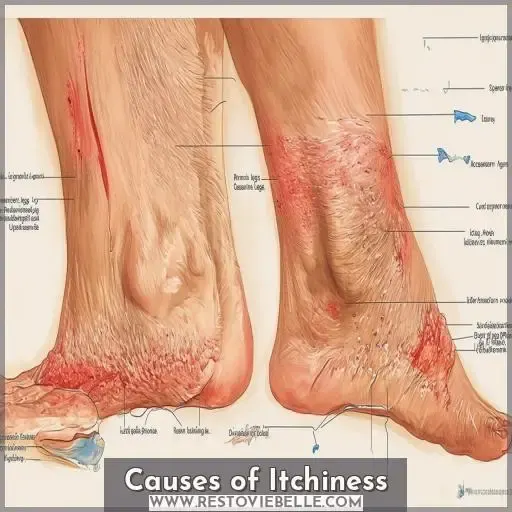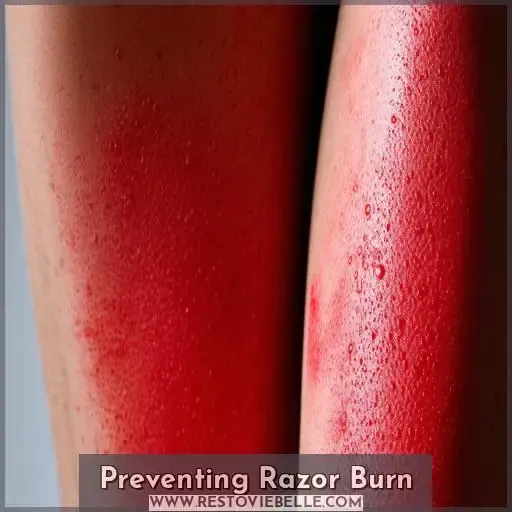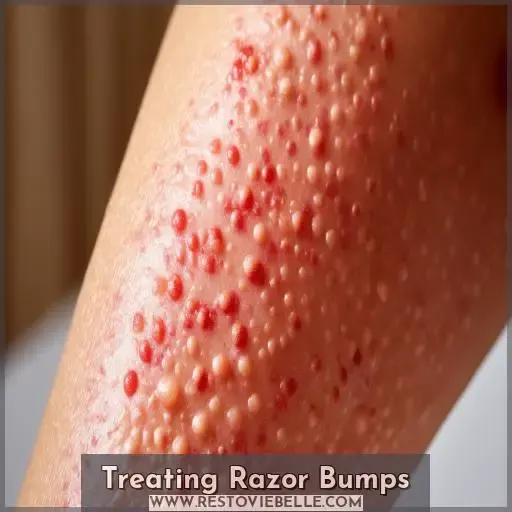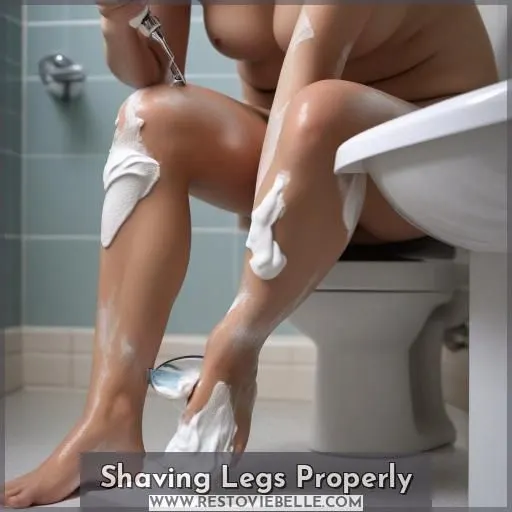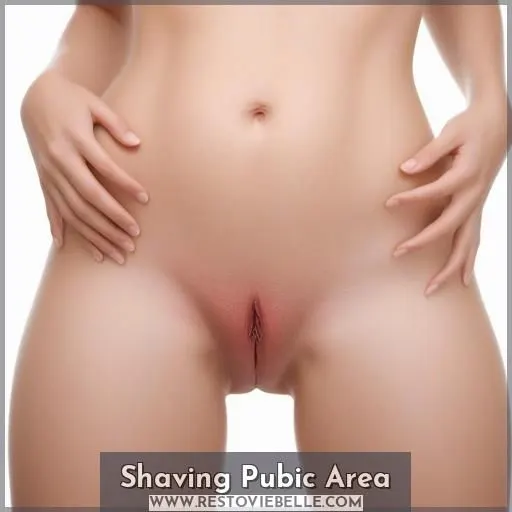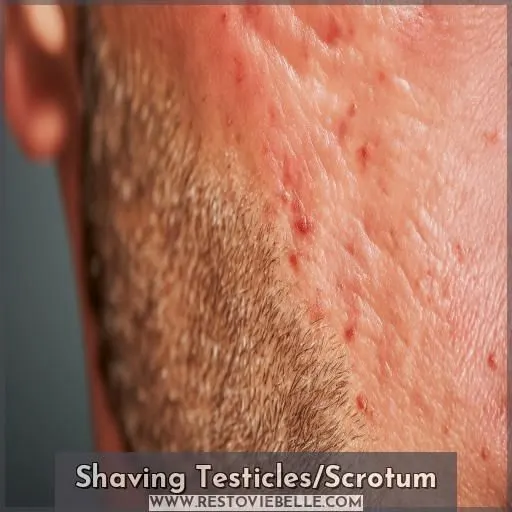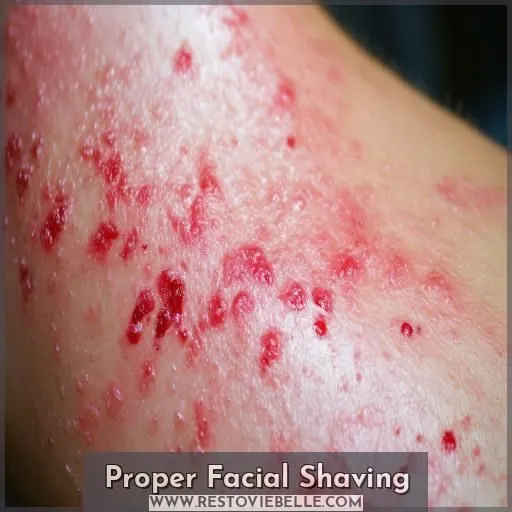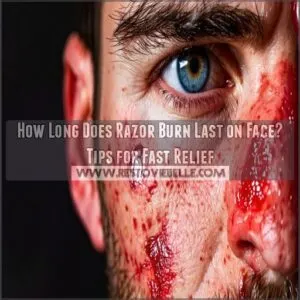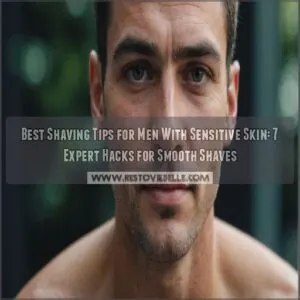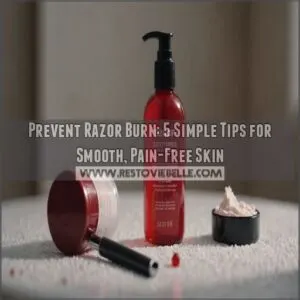This site is supported by our readers. We may earn a commission, at no cost to you, if you purchase through links.
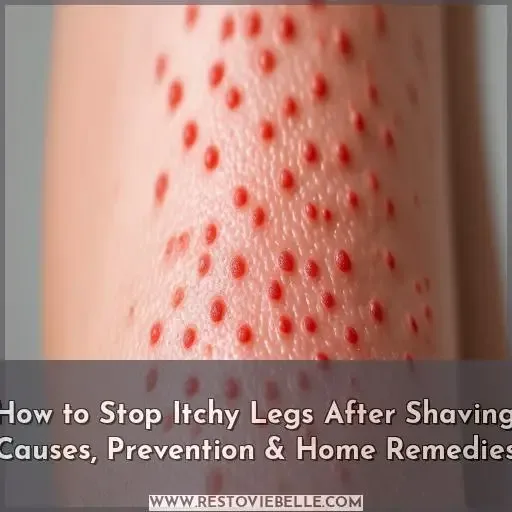 To stop itchy legs after shaving, take these steps:
To stop itchy legs after shaving, take these steps:
Use a sharp, high-quality razor and shave in the direction of hair growth with a moisturizing shave gel.
Avoid over-shaving the same area.
After shaving, rinse with cool water and apply a fragrance-free moisturizer to soothe irritation.
For persistent itchiness or ingrown hairs, gently exfoliate and apply a hydrocortisone cream.
With proper technique and the right products, you can prevent that maddening post-shave itch and keep your legs silky smooth.
But don’t stop there – we’ve got even more tips for achieving the perfect shave.
Table Of Contents
- Key Takeaways
- How to Stop Itchy Legs After Shaving?
- Causes of Itchiness
- Preventing Razor Burn
- Treating Razor Bumps
- Shaving Legs Properly
- Shaving Pubic Area
- Shaving Testicles/Scrotum
- Proper Facial Shaving
- Home Remedies
- When to See Doctor
- Frequently Asked Questions (FAQs)
- How long will I be itchy after shaving?
- Why are my legs so itchy when hair grows back?
- How do I get my legs to stop itching?
- Why are my legs still prickly after shaving?
- What are the best aftershave products to use?
- How often should you replace your razor?
- Can waxing reduce ingrown hairs and irritation?
- Whats the difference between shaving gels and creams?
- Are there any supplements that can help?
- Conclusion
Key Takeaways
- The key to silky smooth legs? A sharp, high-quality razor paired with a moisturizing shave gel – dull blades are a recipe for irritation!
- Shave in the direction of hair growth, my friend. Going against the grain is like swimming upstream – you’ll just end up with angry, inflamed skin.
- After the deed is done, soothe your skin with a cool rinse and a fragrance-free moisturizer. It’s like a big, hydrating hug for your legs.
- If itchy bumps persist, don’t lose hope! A little exfoliation and a dab of Hydrocortisone Cream will calm those pesky ingrown hairs down faster than you can say "smooth as silk.
How to Stop Itchy Legs After Shaving?
To stop itchy legs after shaving, apply a fragrance-free, gentle moisturizer to soothe the skin. You can also use a cold compress or hydrocortisone cream to reduce inflammation and itchiness.
Causes of Itchiness
You may experience itchy legs after shaving due to razor burn, which occurs when the razor irritates your skin and hair follicles. Ingrown hairs and folliculitis, an infection of the hair follicles, can also cause itching and irritation after shaving your legs.
Razor Burn Causes
Razor burn causes an itchy, red rash from shaving too fast, using old razors, dry shaving, and harsh shaving products. Poor shaving techniques like going against the grain also lead to razor burn – that stinging, inflamed skin we’d all rather avoid.
Ingrown Hair Causes
You can get ingrown hairs if you shave too close or against the grain. The sharp, curled hair gets trapped under skin, causing irritation. Use proper shaving techniques like shaving with the grain to prevent ingrown hairs that lead to itchy, inflamed bumps.
Folliculitis Triggers
Ingrown hairs aren’t your only itchy foe – folliculitis is a pesky bacterial infection that can occur when you:
- Shave against the hair growth
- Use dull razors or poor technique
- Neglect hygiene before/after shaving
- Fail to moisturize sensitive areas
Avoid this staph-induced scourge by taking proper precautions. Your skin will thank you!
Preventing Razor Burn
To prevent razor burn and the ensuing itchiness when shaving your legs, use sharp razors that glide smoothly over your skin and always shave in the direction of hair growth. Applying a shaving cream or gel helps soften hairs and lubricate the skin for a closer, more comfortable shave.
Use Sharp Razors
Use sharp razors to prevent razor burn on legs. Dull blades tug and irritate skin, causing those itchy red bumps. Replace disposable razors often or maintain reusable blades with a proper sharpening regimen:
| Blade Maintenance | Description |
|---|---|
| Sharpening Stones | Restore blade edge |
| Razor Oil | Lubricate moving parts |
| Replace Blades | When shave quality declines |
Shave With Grain
When shaving your legs, shave in the direction of hair growth. This reduces razor drag and prevents nicks, cuts, and ingrown hairs that cause itchiness. To shave efficiently:
- Map the grain pattern
- Shave with light pressure
- Rinse razor frequently
- Moisturize after shaving
Shaving with the grain prevents ingrown hairs and razor bumps.
Use Shaving Products
You’ll also want to use a shaving cream or gel to lubricate and protect your skin. Choose products without irritating fragrances if you have sensitive skin. For pubic hair, trim first, then use gentle, unscented shaving products to avoid painful irritation.
Treating Razor Bumps
You can treat razor bumps in several ways.
For minor irritation, apply a cold compress to soothe inflammation, then use a fragrance-free moisturizer.
For more severe bumps, try a medicated hydrocortisone cream to reduce redness and itching. Warm Compresses can also help bring painful bumps to a head.
Curly or coarse hair is prone to ingrown hairs, so consider laser hair removal or chemical exfoliation if razor bumps persist.
In the meantime, avoid tight clothing that could further irritate the area.
Treat any infected bumps with an over-the-counter antibiotic ointment or see a dermatologist for prescription help.
Shaving Legs Properly
To prevent itchy legs after shaving, avoid shaving too frequently, as this can irritate the skin and cause razor burn or ingrown hairs. Additionally, always moisturize your legs immediately after shaving to soothe the skin and reduce irritation.
Avoid Frequent Shaving
You’ll want to avoid shaving your legs too frequently.
Shaving every day can lead to irritation, razor burn, and ingrown hairs.
Aim for shaving every 2-3 days at most.
Use a new razor each time, along with a soothing shaving cream or gel.
Skip the harsh chemical products.
Shaving with warm water also helps open pores for a closer, gentler shave.
Moisturize After Shaving
You’ve tackled the tricky shave, now seal the deal with moisturizer. Look for gentle, fragrance-free formulas packed with nourishing ingredients like shea butter and vitamin E. If you’re crafty, whip up a homemade body butter using coconut oil and honey. Slather it on to soothe razor burn and lock in hydration. Never use alcohol-based products post-shave – that’ll sting!
Shaving Pubic Area
When shaving the pubic area, it’s essential to trim longer hairs first to prevent painful tugs and pulls. Opt for fragrance-free shaving products, as fragrances can further irritate the sensitive skin in this region.
Trim Before Shaving
Before shaving your pubic area, trim the hair first with:
- Sharp scissors
- Small grooming clippers
- Dedicated beard trimmer
Trimming reduces the risk of ingrown hairs and irritation. Aim for a 1⁄4 inch length – short enough to shave easily, but long enough to avoid severe skin irritation from shaving too close.
Use Fragrance-Free Products
Opt for fragrance-free shaving creams, gels, and moisturizers when grooming your pubic area. The delicate skin down there can be easily irritated by harsh chemicals. After shaving, moisturize regularly with gentle, unscented products to soothe sensitivity. Exfoliating occasionally can also help prevent ingrown hairs from causing dreaded itchiness. Always put your skin’s comfort first.
Shaving Testicles/Scrotum
When shaving the delicate skin of the testicles and scrotum, hold the area taut to make the skin smooth and tight. Use gentle pressure with your razor to avoid nicks and cuts on this sensitive region.
Hold Skin Taut
When shaving your testicles and scrotum, holding the skin taut is essential for a smooth shave. Try:
- Gently pulling the skin tight with one hand
- Keeping the skin stretched in the direction you’re shaving
- Using your free fingers to create a taut surface
A firm grip ensures the razor glides effortlessly, minimizing nicks and cuts. Controlling the pressure and keeping skin tightened during each stroke leads to precise, irritation-free hair removal.
Gentle Pressure
When shaving the delicate testicle and scrotum area, apply only gentle pressure. Pressing too hard can cause nicks, cuts, and excessive skin irritation. Let the sharp razor do the work – it doesn’t require much force. Gentle, careful strokes minimize irritation and razor burn in this sensitive region.
Proper Facial Shaving
For proper facial shaving, you’ll want to thoroughly soften your facial hair with warm water or a pre-shave oil before shaving. Rinse your razor frequently while shaving to prevent clogging and irritation.
Soften Hair First
To properly shave your face, you must first soften the hair. This prevents nicks, cuts, and irritation. Try:
- Washing face with warm water to open pores
- Using a pre-shave oil or balm
- Letting shaving cream soak for 2-3 minutes
- Exfoliating gently to remove dead skin cells
Softening the hair makes it easier for the razor to cut cleanly. It also reduces inflammation and ingrown hairs – the primary causes of that dreaded shave itch.
Rinse Razor Frequently
To prevent ingrown hairs, rinse your razor thoroughly after each stroke, avoiding chemicals and minimizing pressure. Shaving against the hair growth increases irritation, so follow its natural direction.
| Rinse Razor | Avoid Chemicals | Minimal Pressure |
|---|---|---|
| After Each Stroke | Use Shaving Cream | Go With Hair Growth |
| Prevents Buildup | No Harsh Products | Reduces Irritation |
| Clears Debris | Fragrance-Free | Prevents Ingrowns |
Home Remedies
To soothe itchy, irritated legs after shaving, apply a thin layer of over-the-counter hydrocortisone cream to reduce inflammation and discomfort. You can also hold a warm, damp compress against the affected areas for 10-15 minutes to help calm razor burn and ingrown hairs.
Hydrocortisone Cream
You can use hydrocortisone cream to soothe skin irritation after shaving. It:
- Reduces inflammation
- Calms itchiness/redness
- Is gentle on sensitive skin
- Comes in over-the-counter strengths
- Should be applied as a thin layer
Hydrocortisone provides relief from razor burn, ingrown hairs, and other shaving irritants. Just be sure to follow instructions for proper usage.
Warm Compresses
To soothe itchy, inflamed skin after shaving your legs, try warm compresses. The gentle heat helps reduce redness and calm irritation. Simply run a clean washcloth under warm water, wring out the excess, and hold it against the affected areas for 5-10 minutes.
| Relief | Redness | Inflammation |
|---|---|---|
| Warm | Fades | Calmed |
| Soothing | Disappears | Reduced |
| Ahhh… | Gone | Goodbye! |
Warm compresses provide much-needed relief for that post-shave itchiness. Give your skin a little TLC – it deserves it!
When to See Doctor
You should see a doctor if the itchiness and redness persist for more than a few days after shaving, as this could indicate an infection or other underlying condition. Additionally, seek medical attention if you notice signs of infection such as pus, excessive swelling, or fever, as these require prompt treatment.
Persistent Redness/Itching
You should see a doctor if the itchy skin and redness persist for more than 3 days after trying home remedies. Prolonged irritation could indicate an underlying issue with your shaving technique or sensitive skin. A dermatologist can assess if it’s razor irritation and recommend medical treatments to soothe your itchy, inflamed skin when home remedies fail.
Signs of Infection
You’ll want to see a doc if redness, itching, crust, blood, or pus appears around hair follicles in the days post-shave. These signs indicate inflammation or infection, which needs prompt treatment. Look out for:
- Throbbing, swollen bumps
- Spreading redness
- Yellow or green discharge
- Fever or chills
- Increasing pain
Don’t ignore these symptoms – they require medical attention to prevent worsening.
Frequently Asked Questions (FAQs)
How long will I be itchy after shaving?
You’ll likely be itchy for 1-3 days after shaving. But don’t fret – keeping skin moisturized and avoiding tight clothes will soothe that itch while your hair regrows.
Why are my legs so itchy when hair grows back?
You’re itchy because the new hair is stubble-sharp as it grows back after shaving. This irritates your skin from within the follicles, causing that maddening itch. Moisturize well and use a gentle exfoliator to reduce irritation until it passes.
How do I get my legs to stop itching?
Imagine being free from that irritating itch! Use a gentle exfoliant, moisturize regularly, and wear loose clothing to stop the madness after shaving.
Why are my legs still prickly after shaving?
Your legs are still prickly because shaving irritates the hair follicles, causing razor burn or ingrown hairs. To prevent this, use a sharp razor and shave in the direction of hair growth. Also, moisturize well after shaving to soothe the skin.
What are the best aftershave products to use?
Soothe sizzling skin with serene salves – slather on sensitive shaving serums laced with liquefying, gentle glycerin and nature’s nurturing aloe. Let liberation luxuriate.
How often should you replace your razor?
You should replace your razor every 5-7 shaves. Dull blades tug at hairs, causing irritation and ingrown hairs. Invest in high-quality razors and let your skin renew itself between shaves.
Can waxing reduce ingrown hairs and irritation?
As smooth as a baby’s bottom, waxing can reduce ingrown hairs and irritation by removing hair from the root. This exfoliation-like process allows hairs to grow back evenly, preventing the dreaded razor bumps.
Whats the difference between shaving gels and creams?
Shaving gels tend to be thicker and more protective, creating a richer lather to soothe skin. Creams are lighter and allow for a closer shave, but may leave skin feeling drier. Choose based on your razor and skin sensitivities.
Are there any supplements that can help?
You can try taking vitamin C or zinc supplements to support skin health and healing. However, shaving properly with a gentle technique is more effective for preventing itchiness after hair removal.
Conclusion
Up to 25% of individuals experience itchy legs after shaving. Mastering how to stop itchy legs after shaving requires using a quality razor, shaving in the hair’s direction, applying moisturizer post-shave, and treating ingrown hairs. With patience and proper technique, you can combat the irritating itch and maintain smooth skin.
